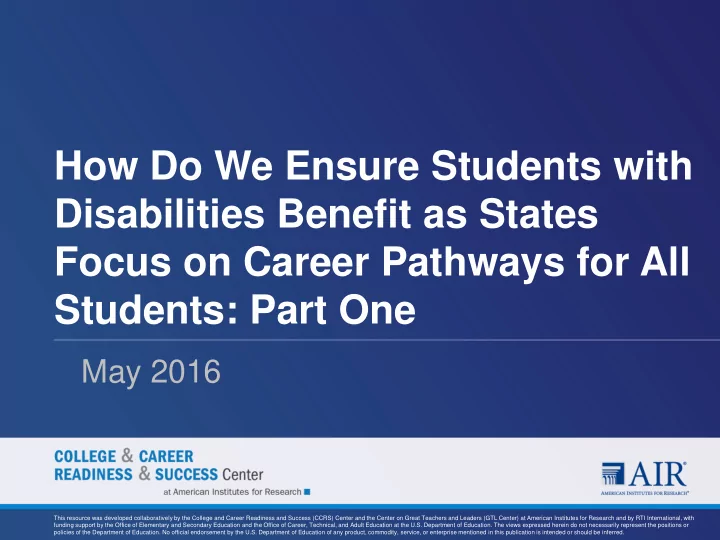

How Do We Ensure Students with Disabilities Benefit as States Focus on Career Pathways for All Students: Part One May 2016 This resource was developed collaboratively by the College and Career Readiness and Success (CCRS) Center and the Center on Great Teachers and Leaders (GTL Center) at American Institutes for Research and by RTI International, with funding support by the Office of Elementary and Secondary Education and the Office of Career, Technical, and Adult Education at the U.S. Department of Education. The views expressed herein do not necessarily represent the positions or policies of the Department of Education. No official endorsement by the U.S. Department of Education of any product, commodity, service, or enterprise mentioned in this publication is intended or should be inferred.
Agenda Introductions Audience Perspectives Overview of Career Pathways CCRS Career Pathways Modules 2
Objectives Participants will be able to: Discuss what career pathways are and how they can help students with disabilities (SWD) Discuss the people, organizations, and processes necessary to establish or strengthen career pathways systems Identify possible entry points for district and state leaders wishing to strengthen career pathways systems for SWD 3
Audience Perspectives • What do you think of when you think of career pathways? • What initiatives are you familiar with in your state or district (if any)? • How are career pathways important for your students with disabilities?
What Are Career Pathways? • Career Pathways are a coordinated system of programs and services supporting students in the transition from school to the workforce, and it can be one part of a comprehensive system to support students’ college and career readiness. • Often defined similarly as programs of study, which are the series of courses students take in secondary and post- secondary as part of a career pathway.
Common Components of Career Pathways Systems Career exploration programs and courses in elementary, middle, and high school Articulated series of courses in high school and postsecondary Industry certifications and credentials Work-based learning experiences
Career Pathways 7
Career Pathways 8
Career Pathways 9
Career Pathways and Students with Disabilities • Students with disabilities (SWD) have high rate of participation in CTE, which typically has stronger career pathways But, SWD are sometimes seen as exempt from these pathways because o they are too rigorous • Secondary and postsecondary administrators often focus on academic success and postsecondary placement for SWD But, generally there is less focus on regional workforce needs or o initiatives so opportunities may be misaligned Schools struggle to give SWD and their families adequate guidance to o gain marketable skills and choose stable career paths
CCRS Career Pathways Modules 11
Career Pathways Modules • Set of resources that provides SEAs with a process for designing or strengthening a career pathways system • Designed to help states and districts connect K-12, postsecondary, and workforce or volunteer experiences • Overall goal is to strengthen career pathways systems to – Improve students’ college and career readiness – Increase youth employment opportunities – Build or strengthen partnerships between education agencies and industry leaders 12
Designing a Career Pathways System: A Framework for State Education Agencies A guide for facilitators at a State Education Agency (SEA) Includes guide, handouts and supplementary resources, and PowerPoint Presentation Lead SEA through process of designing and implementing a career pathways system
Designing a Career Pathways System: A Framework for State Education Agencies
Designing a Career Pathways System: A Framework for State Education Agencies Chapter 1: Identifying and Engaging Key Stakeholders and Defining Goals of the Career Pathways System Chapter 2: Mapping and Assessing Career Readiness Policies, Programs, and Industries Chapter 3: Designing a Career Pathways System Framework Chapter 4: Planning for Implementation and Continuous Improvement
Chapter 1: Identifying and Engaging Key Stakeholders and Defining Goals of the Career Pathways System • Involvement of key stakeholders in design and planning process • Clarifying roles & responsibilities • Build stakeholder knowledge • Define goals & prioritize career pathway elements
Career Pathways Module o Handout 1A: Identifying Stakeholders o Who would you want to be involved in career pathways work at each level to advocate for and share information relevant to SWD?
Chapter 2: Mapping and Assessing Career Readiness Policies, Programs, and Industries • Understand state’s career pathways landscape • Mapping inventory of career readiness policies & programs • Initiate labor market gap analysis
Career Pathways Module o Handout 2B: Labor Market Gap Analysis Template o What industries and occupations do your programs serving SWD emphasize? Are they growing or shrinking?
Chapter 3: Designing a Career Pathways System Framework • Complete & review labor market gap analysis • Identify experts from target industries • Prioritize industry focus & develop industry-specific pathways system
Career Pathways Module o Handout 3D: Career Pathways System Framework o What work-based opportunities currently exist for SWD? Postsecondary options?
Chapter 4: Planning for Implementation and Continuous Improvement • Develop comprehensive work plan & monitor implementation • Identify short and long-term metrics • Engage stakeholders in reflection on the implementation process
Career Pathways Module o Handout 4E: Stakeholder Communication Planning o What types of messages about SWD being involved in career pathways would you share? With whom?
Designing a Career Pathways System: A Framework for State Education Agencies www.ccrscenter.org/technical- assistance-networks/career- pathawys-modules
What Next? • Expand career exploration for SWD • Improve communication about career pathways for SWD for parents and educators • Build partnerships with post-secondary institutions to improve programs for SWD • Use the Career Pathways Module resources and processes to establish career pathways that serve SWD in your region
Discussion • What resonates with you? • What stage of the work do you think you are ready to do? • What people or organizations would you want to involve in this work? In what role? • What opportunities do you see? What challenges do you see?
Catherine Jacques 202-403-6323 cjacques@air.org College and Career Readiness and Success Center 1000 Thomas Jefferson Street NW Washington, DC 20007-3835 877-322-8700 gtlcenter@air.org www.gtlcenter.org | www.air.org 27
Recommend
More recommend